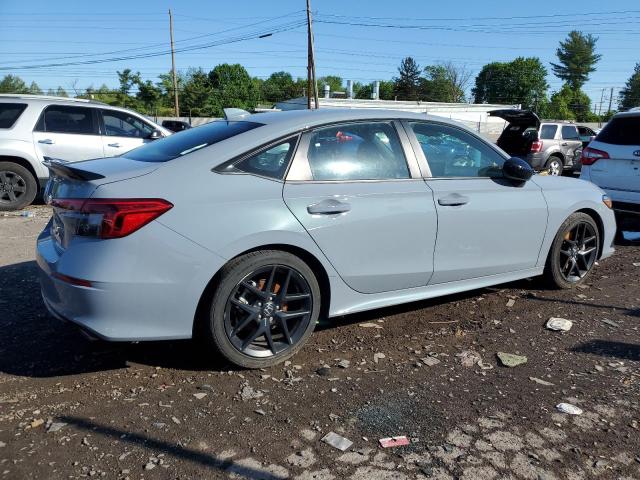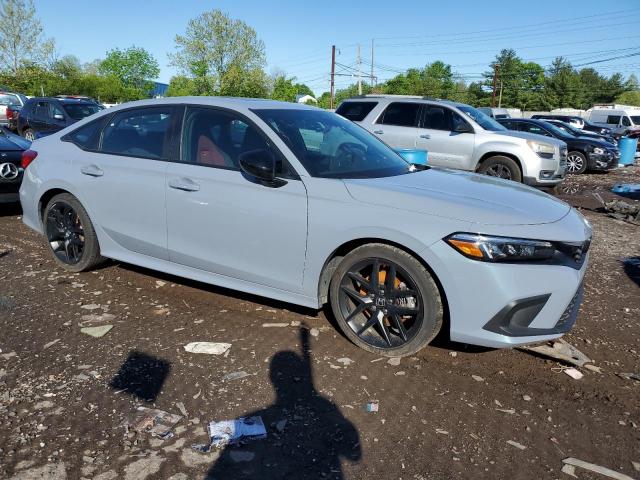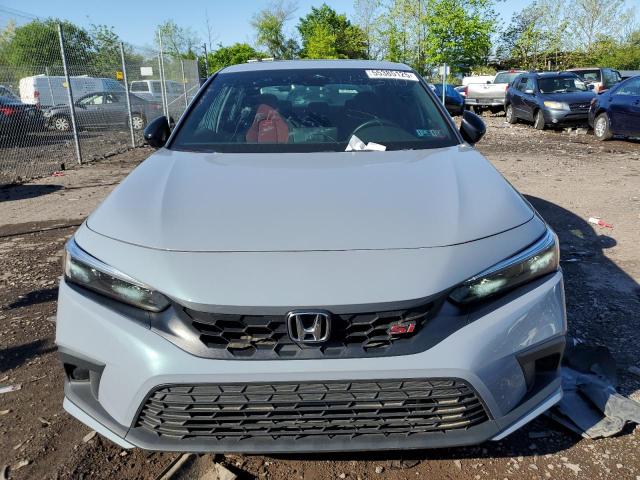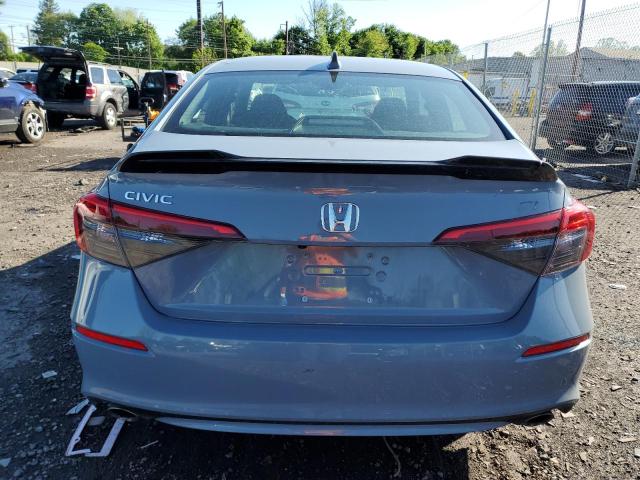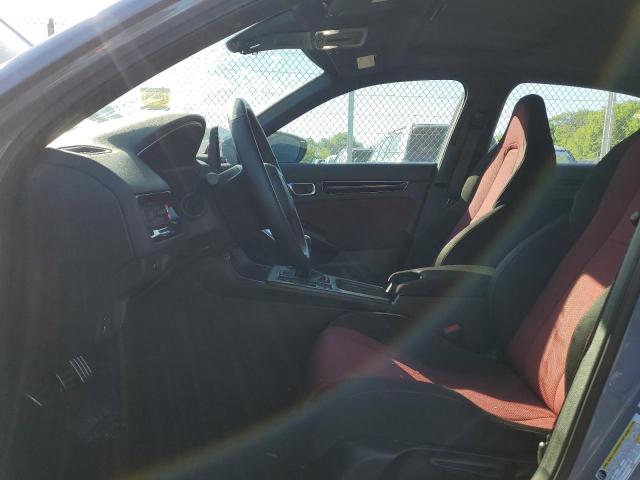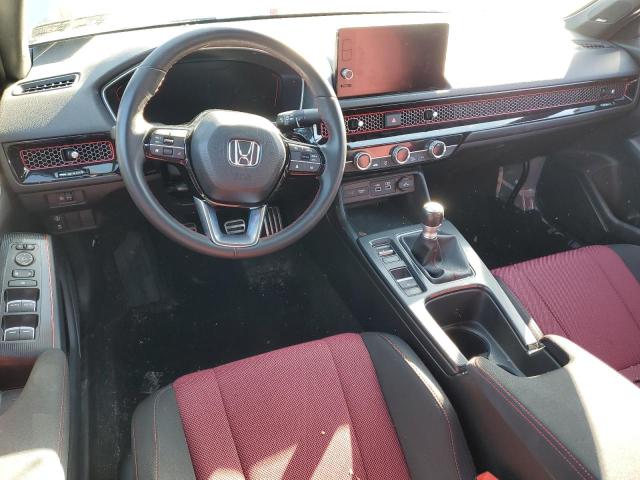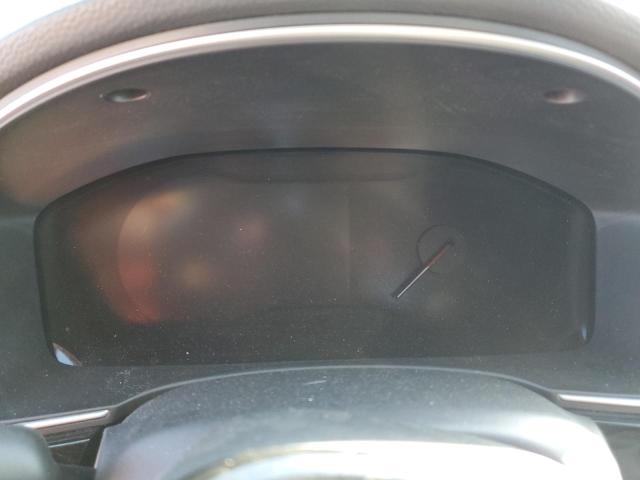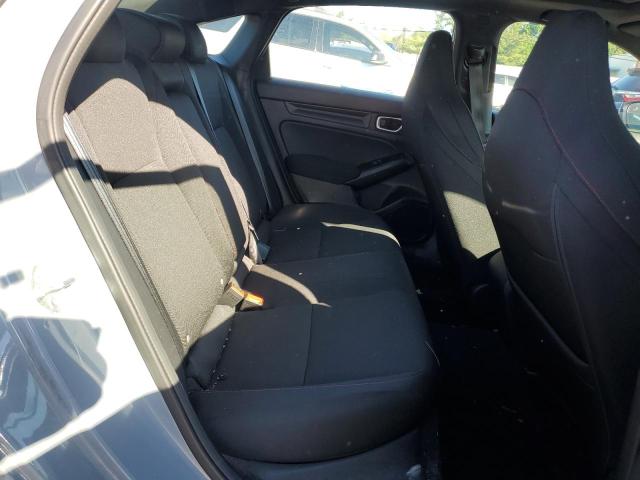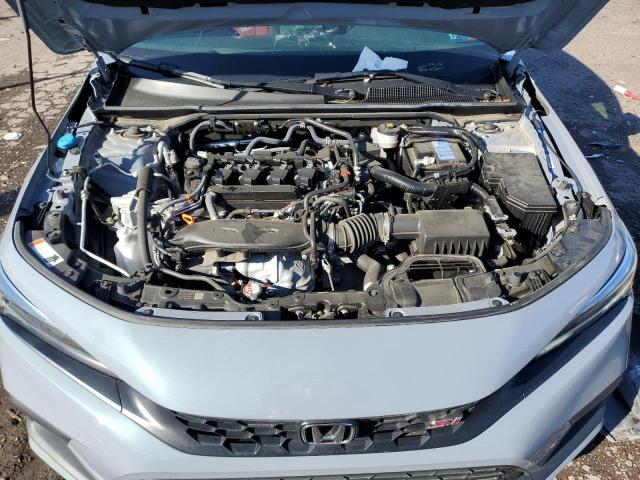2024 HONDA CIVIC SI | 2HGFE1E52RH473110
 ❯
❯
Specifications
4
~$28,000
Engine: 1.5L turbocharged inline-4
Torque: 240 Nm
0–100 km/h: ~7.8 s
The Civic Touring with the 1.5-liter turbocharged engine strikes a confident balance between efficiency and spirited everyday use. It delivers over 170 horsepower with minimal lag, and its broad torque band allows for swift acceleration from stoplights and during highway overtakes. The pairing with a continuously variable transmission ensures that the engine stays within its optimal power range, offering uninterrupted thrust without sacrificing fuel economy. The result is a refined and predictable launch, making the Civic feel eager yet composed.
Underneath, the car rides on an independent suspension layout that favors balance over extremes. The chassis is stiff and low to the ground, giving the Civic a planted feel through corners and lane changes. While the setup leans toward comfort, the steering remains sharp enough to trace precise lines at speed. Body movements are well damped, and the car responds progressively to driver input without twitchiness. It doesn’t push you to drive hard but rewards you when you do.
The character of the Civic lies in how natural everything feels. It doesn’t pretend to be a sports sedan, but it understands rhythm. You settle into a position that feels made for driving, not posing. Throttle, steering, and chassis feedback are cohesive—not dramatic, but always fluent. The car asks nothing of the driver but offers clarity and control, whether you’re carving a backroad or easing through dense traffic. It’s not about performance figures—it’s about the fact that everything moves together as one.
Body Styles
The eleventh-generation Civic is offered as a four-door sedan and five-door hatchback, each designed with a purposeful reduction in visual noise. The roofline of the sedan flows in a continuous arc toward a short rear deck, giving it a fastback-like silhouette while preserving traditional three-box proportions. The hatchback, by contrast, uses a gently arched rear and wide tailgate opening to prioritize versatility, with subtle bulges over the rear fenders that emphasize its stance. Both variants share a long wheelbase that pushes the wheels outward, shortening overhangs and allowing for generous interior space. The beltline sits low, and the hood remains flat and unadorned, creating a clean, horizontal profile. There are no tricks or flourishes—just honest, well-proportioned sheet metal shaped by a clear design language.
Model Name Meaning (Manufacturer)
The name "Civic" reflects the brand’s aspiration to create a car designed for society—accessible, reliable, and useful across generations. It was intended to serve as an answer to the needs of people rather than markets, anchoring the vehicle in a vision of transportation as public good. The name itself is meant to signal community, simplicity, and everyday contribution, rather than performance or luxury.
Model Name Meaning (Languages)
The word "Civic" originates from the Latin civicus, meaning "relating to a citizen." Its usage in modern English implies public engagement, shared responsibility, and civil structure. When applied to a car, it evokes the image of something designed to work harmoniously within the rhythms of city and society, unpretentious yet essential. The name feels transparent, almost universal—like a foundation more than a brand.
Body & Interior Colors and Rims
The Civic’s exterior finishes emphasize clarity of form over spectacle. Neutral tones such as Meteorite Gray, Morning Mist Blue, and Platinum White give the car a soft metallic sheen under natural light, while Rallye Red and Boost Blue provide contrast for those who prefer expression over understatement. The paint follows the body’s simple lines cleanly, with no harsh cutlines or overworked surfacing to distract from the proportions. Subtle gloss black trim surrounds the windows and grille, while higher trims receive chrome elements integrated with restraint.
Inside, the cabin’s design language mirrors the exterior’s clarity. Materials are chosen for texture rather than flash, with soft-touch horizontal planes intersecting a low, clean dashboard. Cloth and leather upholstery come in muted tones—black, gray, or ivory—punctuated by fine stitching and restrained metallic accents. The dashboard vent design is fully concealed behind a linear honeycomb mesh panel that spans the entire width of the cabin, setting the tone for calm uniformity. All controls are mechanical, tactile, and symmetrical. The climate dials click solidly, the shifter sits naturally in reach, and screens are integrated with clear intent.
Wheel offerings range from 16-inch steel with full covers in base trims to 18-inch machined alloys with gloss black inserts in Touring and Sport grades. Their designs are functional and non-distracting—multi-spoke, directional, or V-patterned—intended to support the Civic’s stance rather than dominate it visually. Sidewall height and tire width remain generous enough to preserve ride quality, a deliberate choice in keeping with the car’s user-first design.
Top Expensive Options
- Leather-trimmed seating surfaces: $1,500
- Bose 12-speaker premium audio system: $1,200
- Integrated navigation with 9-inch HD display: $1,000
- Power-adjustable driver’s seat with memory: $800
- Dual-zone climate control with rear vents: $650
- Heated front and rear seats: $600
- Power moonroof with sliding sunshade: $1,000
- 18-inch two-tone alloy wheels: $1,200
- Wireless phone charger and smartphone interface: $500
- Adaptive LED headlights with auto-leveling: $850
vs Competitors
In a class crowded with entries chasing either budget or premium aspirations, the Civic positions itself with quiet confidence. Compared to the Toyota Corolla, it offers sharper steering, more refined chassis behavior, and a more open-feeling cabin. Against the Mazda3, it trades cockpit drama for clean logic and comfort. And unlike newer entrants like the Elantra, it avoids tech gimmicks in favor of mechanical integrity. The Civic doesn’t try to seduce with flamboyant styling or extreme powertrains. Instead, it refines the fundamental qualities that matter most to real drivers: linear control, spatial balance, visibility, and coherence. It’s not the fastest or flashiest—but it’s the most deliberate, and perhaps the most complete.
Fun Fact
Although often viewed as an affordable commuter, the Civic has quietly served as the foundational training ground for generations of driving enthusiasts, tuners, and engineers. Its simple, durable layout has made it a blank canvas for creativity for over four decades. With each generation, it has evolved in complexity and polish, but never abandoned its core architecture. Even today, under its quiet design, the Civic retains the basic mechanical symmetry and drivetrain layout that once made it the platform of choice for grassroots racing teams and DIY dreamers.
Lot Details
-
Sale Date11/Jun/2025
-
Lot Number55385125
-
Sale document
-
Location
-
Odometer13,975 miles (22,491 km)
-
Primary Damage:VANDALISM
-
Fuel
-
Engine Type1.5L 4
-
Transmission
-
Drive Type
-
Color
Final Bid Honda Civic (2024)
$10,000
$11,748
$18,000
Specifications
4
~$28,000
Torque:
0–100 km/h:
The Civic Touring with the 1.5-liter turbocharged engine strikes a confident balance between efficiency and spirited everyday use. It delivers over 170 horsepower with minimal lag, and its broad torque band allows for swift acceleration from stoplights and during highway overtakes. The pairing with a continuously variable transmission ensures that the engine stays within its optimal power range, offering uninterrupted thrust without sacrificing fuel economy. The result is a refined and predictable launch, making the Civic feel eager yet composed.
Underneath, the car rides on an independent suspension layout that favors balance over extremes. The chassis is stiff and low to the ground, giving the Civic a planted feel through corners and lane changes. While the setup leans toward comfort, the steering remains sharp enough to trace precise lines at speed. Body movements are well damped, and the car responds progressively to driver input without twitchiness. It doesn’t push you to drive hard but rewards you when you do.
The character of the Civic lies in how natural everything feels. It doesn’t pretend to be a sports sedan, but it understands rhythm. You settle into a position that feels made for driving, not posing. Throttle, steering, and chassis feedback are cohesive—not dramatic, but always fluent. The car asks nothing of the driver but offers clarity and control, whether you’re carving a backroad or easing through dense traffic. It’s not about performance figures—it’s about the fact that everything moves together as one.
Body Styles
The eleventh-generation Civic is offered as a four-door sedan and five-door hatchback, each designed with a purposeful reduction in visual noise. The roofline of the sedan flows in a continuous arc toward a short rear deck, giving it a fastback-like silhouette while preserving traditional three-box proportions. The hatchback, by contrast, uses a gently arched rear and wide tailgate opening to prioritize versatility, with subtle bulges over the rear fenders that emphasize its stance. Both variants share a long wheelbase that pushes the wheels outward, shortening overhangs and allowing for generous interior space. The beltline sits low, and the hood remains flat and unadorned, creating a clean, horizontal profile. There are no tricks or flourishes—just honest, well-proportioned sheet metal shaped by a clear design language.
Model Name Meaning (Manufacturer)
The name "Civic" reflects the brand’s aspiration to create a car designed for society—accessible, reliable, and useful across generations. It was intended to serve as an answer to the needs of people rather than markets, anchoring the vehicle in a vision of transportation as public good. The name itself is meant to signal community, simplicity, and everyday contribution, rather than performance or luxury.
Model Name Meaning (Languages)
The word "Civic" originates from the Latin civicus, meaning "relating to a citizen." Its usage in modern English implies public engagement, shared responsibility, and civil structure. When applied to a car, it evokes the image of something designed to work harmoniously within the rhythms of city and society, unpretentious yet essential. The name feels transparent, almost universal—like a foundation more than a brand.
Body & Interior Colors and Rims
The Civic’s exterior finishes emphasize clarity of form over spectacle. Neutral tones such as Meteorite Gray, Morning Mist Blue, and Platinum White give the car a soft metallic sheen under natural light, while Rallye Red and Boost Blue provide contrast for those who prefer expression over understatement. The paint follows the body’s simple lines cleanly, with no harsh cutlines or overworked surfacing to distract from the proportions. Subtle gloss black trim surrounds the windows and grille, while higher trims receive chrome elements integrated with restraint.
Inside, the cabin’s design language mirrors the exterior’s clarity. Materials are chosen for texture rather than flash, with soft-touch horizontal planes intersecting a low, clean dashboard. Cloth and leather upholstery come in muted tones—black, gray, or ivory—punctuated by fine stitching and restrained metallic accents. The dashboard vent design is fully concealed behind a linear honeycomb mesh panel that spans the entire width of the cabin, setting the tone for calm uniformity. All controls are mechanical, tactile, and symmetrical. The climate dials click solidly, the shifter sits naturally in reach, and screens are integrated with clear intent.
Wheel offerings range from 16-inch steel with full covers in base trims to 18-inch machined alloys with gloss black inserts in Touring and Sport grades. Their designs are functional and non-distracting—multi-spoke, directional, or V-patterned—intended to support the Civic’s stance rather than dominate it visually. Sidewall height and tire width remain generous enough to preserve ride quality, a deliberate choice in keeping with the car’s user-first design.
Top Expensive Options
- Leather-trimmed seating surfaces: $1,500
- Bose 12-speaker premium audio system: $1,200
- Integrated navigation with 9-inch HD display: $1,000
- Power-adjustable driver’s seat with memory: $800
- Dual-zone climate control with rear vents: $650
- Heated front and rear seats: $600
- Power moonroof with sliding sunshade: $1,000
- 18-inch two-tone alloy wheels: $1,200
- Wireless phone charger and smartphone interface: $500
- Adaptive LED headlights with auto-leveling: $850
vs Competitors
In a class crowded with entries chasing either budget or premium aspirations, the Civic positions itself with quiet confidence. Compared to the Toyota Corolla, it offers sharper steering, more refined chassis behavior, and a more open-feeling cabin. Against the Mazda3, it trades cockpit drama for clean logic and comfort. And unlike newer entrants like the Elantra, it avoids tech gimmicks in favor of mechanical integrity. The Civic doesn’t try to seduce with flamboyant styling or extreme powertrains. Instead, it refines the fundamental qualities that matter most to real drivers: linear control, spatial balance, visibility, and coherence. It’s not the fastest or flashiest—but it’s the most deliberate, and perhaps the most complete.
Fun Fact
Although often viewed as an affordable commuter, the Civic has quietly served as the foundational training ground for generations of driving enthusiasts, tuners, and engineers. Its simple, durable layout has made it a blank canvas for creativity for over four decades. With each generation, it has evolved in complexity and polish, but never abandoned its core architecture. Even today, under its quiet design, the Civic retains the basic mechanical symmetry and drivetrain layout that once made it the platform of choice for grassroots racing teams and DIY dreamers.


